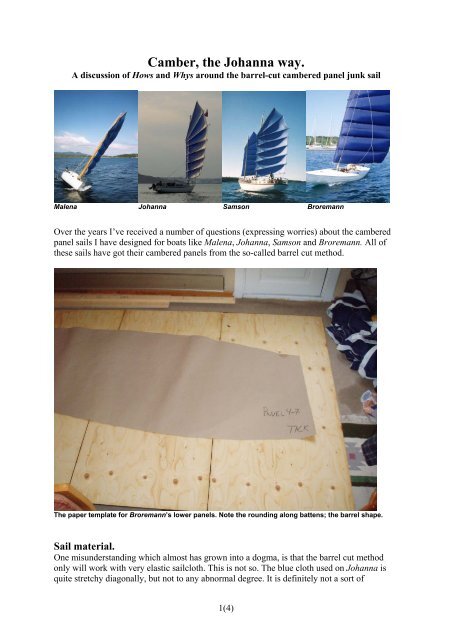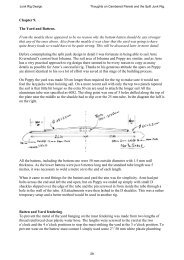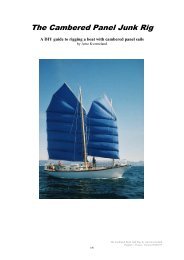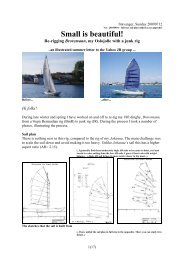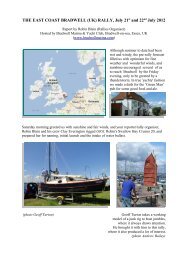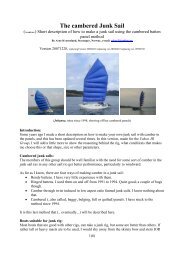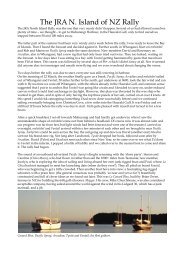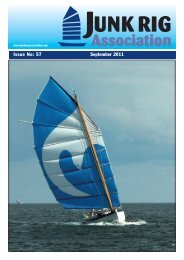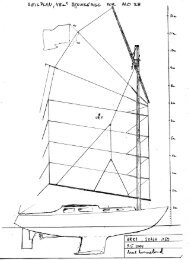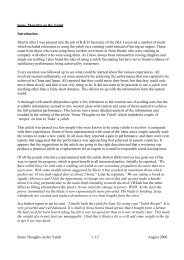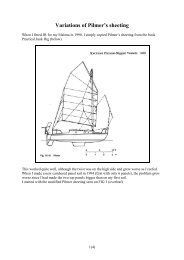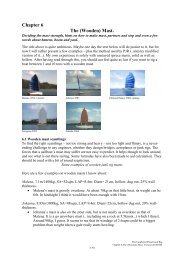20091119 Camber, the Johanna way.pdf - The Junk Rig Association
20091119 Camber, the Johanna way.pdf - The Junk Rig Association
20091119 Camber, the Johanna way.pdf - The Junk Rig Association
- No tags were found...
You also want an ePaper? Increase the reach of your titles
YUMPU automatically turns print PDFs into web optimized ePapers that Google loves.
<strong>Camber</strong>, <strong>the</strong> <strong>Johanna</strong> <strong>way</strong>.A discussion of Hows and Whys around <strong>the</strong> barrel-cut cambered panel junk sailMalena <strong>Johanna</strong> Samson BroremannOver <strong>the</strong> years I’ve received a number of questions (expressing worries) about <strong>the</strong> camberedpanel sails I have designed for boats like Malena, <strong>Johanna</strong>, Samson and Broremann. All of<strong>the</strong>se sails have got <strong>the</strong>ir cambered panels from <strong>the</strong> so-called barrel cut method.<strong>The</strong> paper template for Broremann’s lower panels. Note <strong>the</strong> rounding along battens; <strong>the</strong> barrel shape.Sail material.One misunderstanding which almost has grown into a dogma, is that <strong>the</strong> barrel cut methodonly will work with very elastic sailcloth. This is not so. <strong>The</strong> blue cloth used on <strong>Johanna</strong> isquite stretchy diagonally, but not to any abnormal degree. It is definitely not a sort of1(4)
navalised Lycra! Some years ago Don Taylor sent me a sample of <strong>the</strong> Odyssy III cloth and Ifound it to be just as stretchy as my blue cloth. In fact, when studying both cloths under amagnifying glass, it appeared to me that <strong>the</strong>y were woven in <strong>the</strong> same <strong>way</strong>. In both cases Ifound <strong>the</strong>m impossible to rip with hand force.<strong>The</strong> German yacht Peregrine has a big JR with barrel cut panels. AFAIK it has been madefrom ordinary Dacron sail cloth, not very light ei<strong>the</strong>r. That boat sails very well.In Peregrine’s sail <strong>the</strong>re are not many wrinkles along <strong>the</strong> battens. I think Sebastian has stretched <strong>the</strong> saila bit more along <strong>the</strong> battens than I do. This limits <strong>the</strong> camber a bit, but also makes <strong>the</strong> vertical curve moretrapeze-like than in my sails with slacker setup. We had a hard time overtaking Peregrine in <strong>Johanna</strong>...Vertical curve.One argument I often hear against <strong>the</strong> barrel cut method is that one only gets <strong>the</strong> designedcamber on a little spot mid-between <strong>the</strong> battens.Broremann’s barrel cut panelsKingfisher 26, boom-shelf cut panels2(4)
<strong>The</strong> diagram above shows <strong>the</strong> curves at <strong>the</strong> vertical cut through <strong>the</strong> max camber point in 3 different sails.When I made <strong>the</strong> first barrel-cut sail for Malena, I too was concerned that only a part of <strong>the</strong>sail area would actually be working. I already had experience with a flat sail and hingedbattens sail (same size), so was curious about how this one would compare. I needed not haveworried; <strong>the</strong> cambered panel sail was at least as fast to windward as <strong>the</strong> hinged batten sail.One may think that <strong>the</strong> reason for Malena’s and <strong>Johanna</strong>’s success is mainly <strong>the</strong> high SA/dispratio. Not so with <strong>the</strong> schooner Samson. Despite having a SA/disp of just 13.3 she has provento be a good sailer, even in fairly light winds (F3).I can’t prove it yet, but my hunch is that this is what is happening at <strong>the</strong> barrel-cut panels: Close to <strong>the</strong> luff, <strong>the</strong> <strong>Johanna</strong>-style batten panels indeed have a trapeze shape with avery narrow groove at <strong>the</strong> battens. <strong>The</strong> incoming wind will thus see an almost uniformleading edge. In o<strong>the</strong>r words, <strong>the</strong> angle between <strong>the</strong> incoming wind and leading edgeis almost constant. <strong>The</strong> same happens at <strong>the</strong> trailing edge: <strong>The</strong> vertical curve between <strong>the</strong> battens is nearlystraight (trapeze or rectangle). This forces <strong>the</strong> air to leave <strong>the</strong> sail with <strong>the</strong> same angleof departure. I’m not sure what happens in <strong>the</strong> middle (max camber position), but my hunch is that<strong>the</strong> viscosity of <strong>the</strong> air ensures that <strong>the</strong> air passing over <strong>the</strong> groove more or less takes<strong>the</strong> same route as <strong>the</strong> air passing over <strong>the</strong> hump. By <strong>the</strong> <strong>way</strong>; <strong>the</strong>re is no guaranteethat <strong>the</strong> wind will just pass along <strong>the</strong> batten panels – it may well pass diagonally forwhat I know.<strong>The</strong> key thing in my opinion is how <strong>the</strong> wind enters and leaves <strong>the</strong> sail. My telltales at <strong>the</strong>leech definitely indicate a healthy airflow across <strong>the</strong> sail (until I stall it by over-sheeting it),but I see now that I should also fit telltales at each batten, not only at <strong>the</strong> middle of each3(4)
panel, as today. If <strong>the</strong>se extra telltales indicate a nice airflow, <strong>the</strong>n I declare that <strong>the</strong> whole sailis working.In real life I don’t want more total force out of <strong>Johanna</strong>’s sail than I have today. With today’ssetup with 8% camber (or should I say “8” ?) and a SA/disp=23, I can carry almost as muchsail upwind as downwind. If I increased <strong>the</strong> camber, I would have to reef earlier when closehauledand <strong>the</strong>n I would have to un-reef each time I fell off to a run. With my sort of sailing,in and out among islands, that would be quite awkward. I could however use a more closewindedrig, but am unwilling to pay for it in money or trouble (read: carbon mast or wingsail).Nothing negative on <strong>the</strong> boom shelf method: It may well give at least as powerful sails as <strong>the</strong>barrel cut method and it may also end up looking better. But amateur-friendly <strong>the</strong> boom shelfmethod is not. Sewing straight edges to curved ones isn’t easy.ConclusionMost methods of making camber seem to work somehow. <strong>The</strong> important thing if one needbetter progress to windward is to say goodbye to <strong>the</strong> flat sails.Stavanger, <strong>20091119</strong>Regards fromArne Kverneland(a-kve2@online.no).. winter is when <strong>the</strong> Fuji heater is back on board. That happened last week so now I am ready to fry flieson <strong>the</strong> walls again...4(4)


